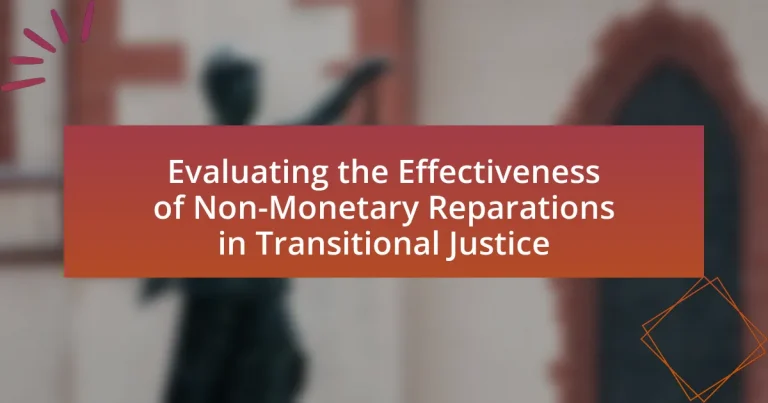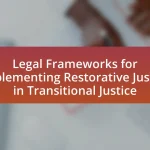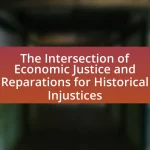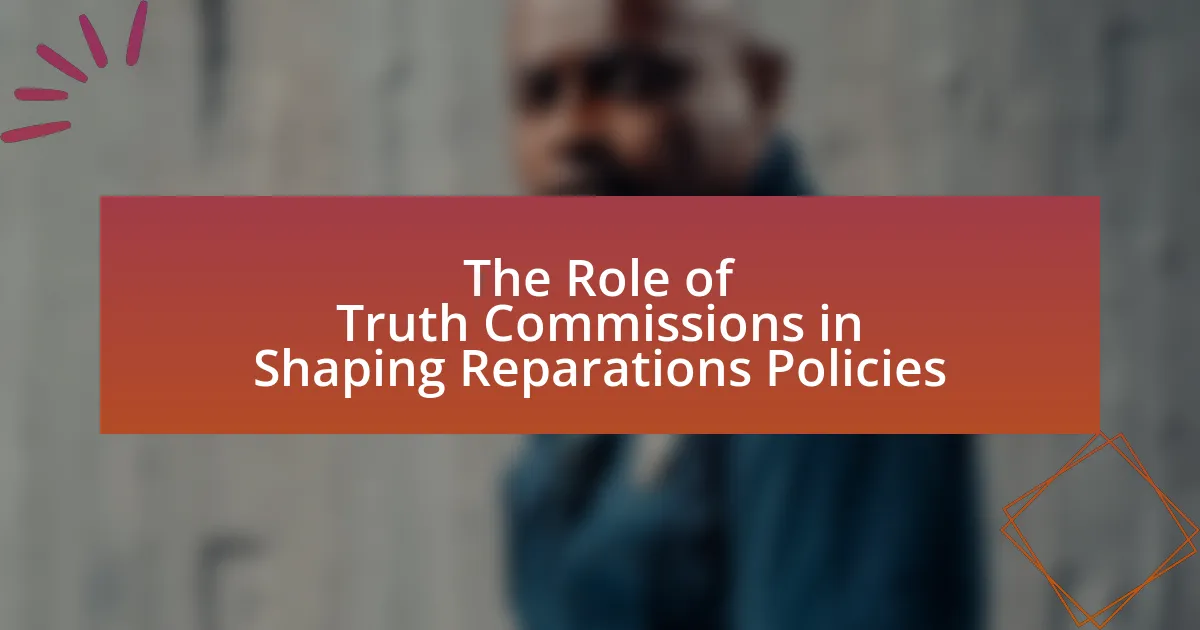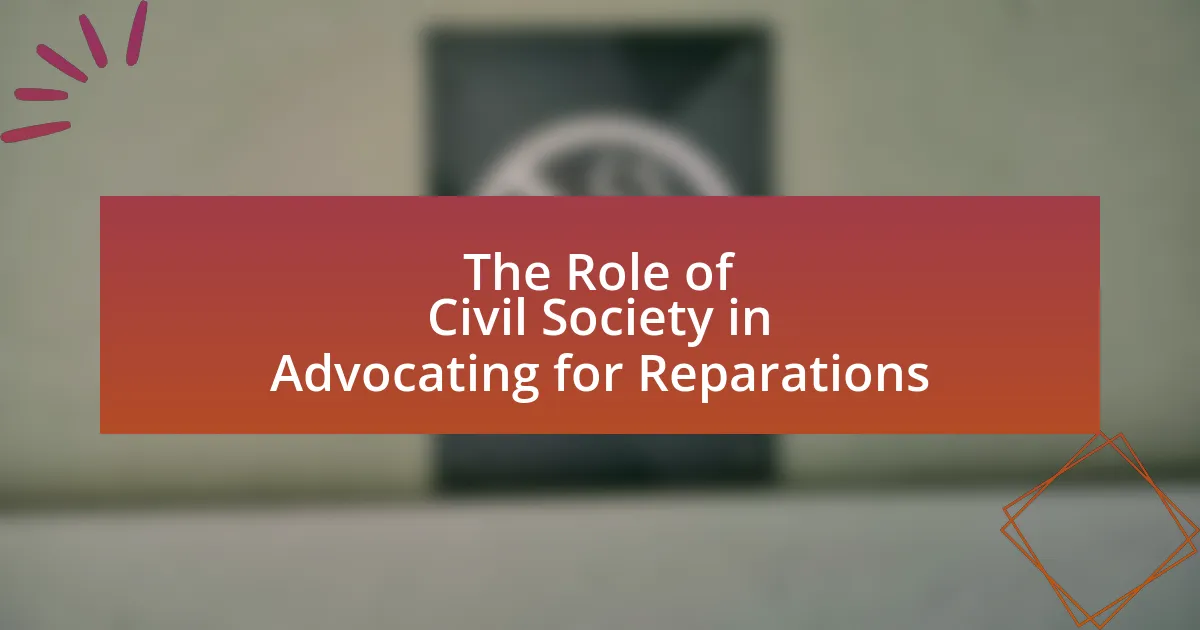Non-monetary reparations in transitional justice are measures aimed at acknowledging and addressing the harm suffered by victims of human rights violations without providing financial compensation. This article evaluates the effectiveness of such reparations, which include public apologies, memorialization, and rehabilitation services, in restoring dignity and promoting healing within affected communities. It explores the differences between non-monetary and monetary reparations, the types commonly implemented, their importance in fostering reconciliation, and the criteria used to assess their effectiveness. Additionally, the article discusses the challenges in measuring impact, methodologies for evaluation, and best practices derived from past implementations, ultimately highlighting the role of community involvement and stakeholder feedback in enhancing the effectiveness and sustainability of non-monetary reparations initiatives.

What are Non-Monetary Reparations in Transitional Justice?
Non-monetary reparations in transitional justice refer to measures that aim to acknowledge and address the harm suffered by victims of human rights violations without providing financial compensation. These reparations can include symbolic acts such as public apologies, memorialization of victims, rehabilitation services, and guarantees of non-recurrence, which collectively seek to restore dignity and promote healing within affected communities. For instance, the Truth and Reconciliation Commission in South Africa emphasized non-monetary reparations by facilitating public hearings and promoting national healing through acknowledgment of past injustices.
How do Non-Monetary Reparations differ from Monetary Reparations?
Non-monetary reparations differ from monetary reparations in that they focus on restoring dignity, acknowledging harm, and providing symbolic gestures rather than direct financial compensation. Non-monetary reparations may include public apologies, memorialization of victims, or community development initiatives, which aim to address the psychological and social dimensions of harm. In contrast, monetary reparations provide financial payments to individuals or communities affected by injustices, aiming to compensate for losses incurred. Historical examples, such as the reparations paid to Holocaust survivors, illustrate monetary reparations, while truth commissions often emphasize non-monetary reparations to foster reconciliation and healing.
What types of Non-Monetary Reparations are commonly implemented?
Commonly implemented types of non-monetary reparations include acknowledgment of harm, apologies, memorialization, and rehabilitation services. Acknowledgment of harm involves official recognition of the injustices suffered by victims, which can help validate their experiences. Apologies are formal expressions of regret from governments or institutions, aimed at fostering reconciliation. Memorialization refers to the establishment of monuments or commemorative events to honor victims and educate the public about past atrocities. Rehabilitation services provide psychological and medical support to victims, addressing their needs and facilitating recovery. These reparations are essential components of transitional justice, as they aim to restore dignity and promote healing in affected communities.
Why are Non-Monetary Reparations considered important in Transitional Justice?
Non-monetary reparations are considered important in transitional justice because they address the psychological and social needs of victims, fostering healing and reconciliation. These reparations, which can include public apologies, memorialization, and access to services, help restore dignity and acknowledge the suffering endured by individuals and communities. Research indicates that non-monetary reparations can lead to improved social cohesion and trust in institutions, as they demonstrate a commitment to justice and accountability. For instance, the United Nations has emphasized the role of non-monetary reparations in promoting restorative justice, highlighting their effectiveness in creating a more inclusive society post-conflict.
What are the goals of Non-Monetary Reparations?
The goals of Non-Monetary Reparations include acknowledging past injustices, restoring dignity to victims, and promoting social cohesion. These reparations aim to provide symbolic recognition of harm, facilitate healing processes, and foster reconciliation within affected communities. For instance, initiatives such as public apologies, memorialization efforts, and the establishment of truth commissions serve to validate the experiences of victims and contribute to collective memory, thereby addressing historical grievances. Research indicates that these measures can enhance community trust and support long-term peacebuilding efforts, as seen in post-conflict societies like South Africa, where the Truth and Reconciliation Commission played a crucial role in addressing apartheid-era injustices.
How do Non-Monetary Reparations contribute to healing and reconciliation?
Non-monetary reparations contribute to healing and reconciliation by addressing the psychological and social needs of affected communities. These reparations often include symbolic gestures, acknowledgment of harm, and community-building initiatives that foster dialogue and understanding. For instance, truth commissions, which are a form of non-monetary reparation, have been shown to facilitate collective memory and promote healing by allowing victims to share their experiences and receive recognition for their suffering. Research indicates that such processes can lead to improved social cohesion and reduced tensions in post-conflict societies, as seen in countries like South Africa and Rwanda, where non-monetary reparations played a crucial role in the reconciliation process.
What role do Non-Monetary Reparations play in restoring dignity to victims?
Non-monetary reparations play a crucial role in restoring dignity to victims by acknowledging their suffering and validating their experiences. These reparations often include public apologies, memorialization efforts, and access to psychological support, which collectively contribute to the recognition of victims’ rights and experiences. For instance, in post-apartheid South Africa, the Truth and Reconciliation Commission emphasized the importance of non-monetary reparations, leading to public acknowledgments of victims’ suffering and the establishment of memorials, which helped to restore a sense of dignity and community identity. Such measures not only provide emotional healing but also foster societal recognition of injustices, reinforcing the victims’ place within the community and promoting a narrative of healing and reconciliation.
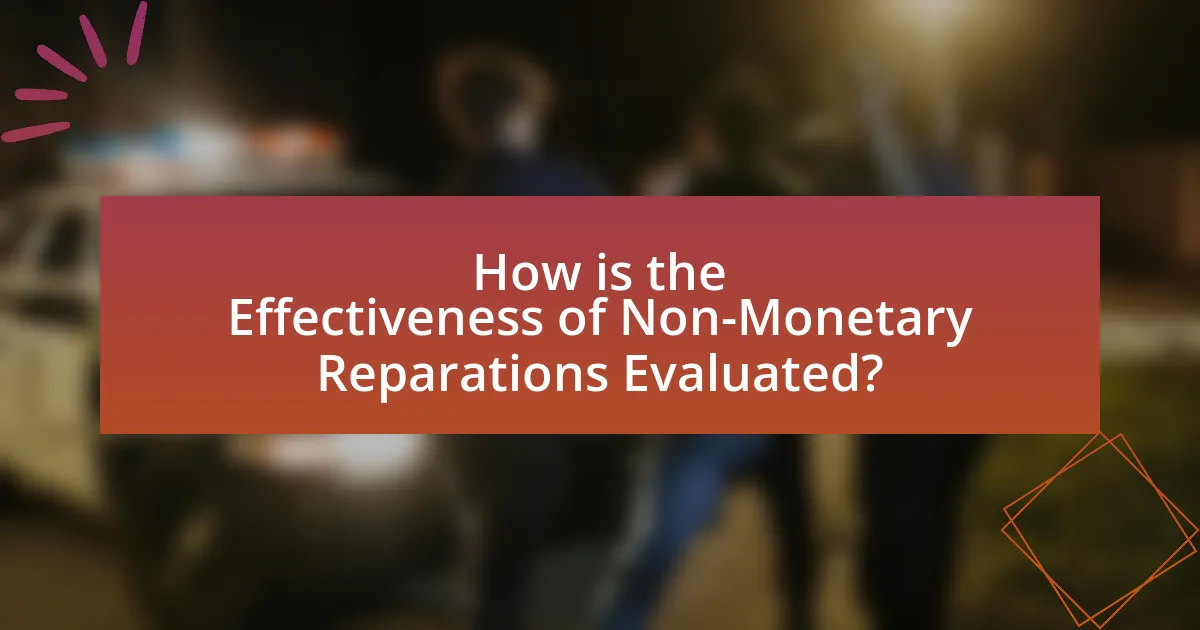
How is the Effectiveness of Non-Monetary Reparations Evaluated?
The effectiveness of non-monetary reparations is evaluated through various qualitative and quantitative measures, including community feedback, psychological assessments, and social impact studies. These evaluations often focus on the extent to which non-monetary reparations, such as public apologies, memorialization efforts, and rehabilitation programs, contribute to healing, reconciliation, and restoration of dignity among affected populations. For instance, research conducted by the International Center for Transitional Justice highlights that successful non-monetary reparations can lead to improved community relations and a sense of justice among victims, thereby reinforcing their social standing and emotional well-being.
What criteria are used to assess the effectiveness of Non-Monetary Reparations?
The effectiveness of Non-Monetary Reparations is assessed using criteria such as acknowledgment of harm, restoration of dignity, psychological healing, and community reintegration. Acknowledgment of harm involves public recognition of the injustices suffered by victims, which is crucial for validating their experiences. Restoration of dignity focuses on measures that empower victims and restore their social status. Psychological healing is evaluated through the impact of reparations on the mental well-being of victims, often measured by changes in trauma symptoms. Community reintegration assesses how well victims are able to reintegrate into their communities post-reparation, which can be influenced by social support and the restoration of relationships. These criteria are supported by frameworks established in transitional justice literature, such as the United Nations Basic Principles and Guidelines on the Right to a Remedy and Reparation.
How do qualitative and quantitative measures differ in evaluating effectiveness?
Qualitative and quantitative measures differ fundamentally in evaluating effectiveness by focusing on distinct aspects of data. Qualitative measures assess subjective experiences, perceptions, and narratives, providing in-depth insights into the impact of non-monetary reparations on individuals and communities. For example, interviews and focus groups can reveal how victims perceive the reparations process and its emotional significance. In contrast, quantitative measures utilize numerical data to evaluate effectiveness through statistical analysis, such as surveys that quantify satisfaction levels or the number of beneficiaries reached. This approach allows for generalizable conclusions about the overall impact of reparations. The combination of both methods can provide a comprehensive understanding of effectiveness, as qualitative insights can contextualize quantitative findings, enhancing the evaluation process in transitional justice.
What challenges arise in measuring the impact of Non-Monetary Reparations?
Measuring the impact of non-monetary reparations presents several challenges, primarily due to the subjective nature of the benefits provided. Non-monetary reparations, such as acknowledgment, apologies, and memorialization, often rely on personal experiences and perceptions, making it difficult to quantify their effectiveness. For instance, the emotional and psychological healing that individuals may experience is inherently subjective and varies widely among recipients, complicating standardized assessment methods. Additionally, the long-term effects of these reparations can be hard to track, as they may manifest over time and be influenced by various external factors, such as social and political contexts. Furthermore, the lack of established metrics for evaluating non-monetary reparations leads to inconsistencies in measurement approaches, making comparative analysis challenging.
What methodologies are commonly used in evaluations?
Common methodologies used in evaluations include qualitative methods, quantitative methods, and mixed-methods approaches. Qualitative methods, such as interviews and focus groups, provide in-depth insights into participants’ experiences and perceptions, which are crucial for understanding the impact of non-monetary reparations. Quantitative methods, including surveys and statistical analysis, allow for the measurement of outcomes and the assessment of the effectiveness of these reparations through numerical data. Mixed-methods approaches combine both qualitative and quantitative techniques, offering a comprehensive view of the evaluation by integrating diverse data sources. These methodologies are essential for accurately assessing the effectiveness of non-monetary reparations in transitional justice contexts.
How do case studies contribute to understanding the effectiveness of Non-Monetary Reparations?
Case studies contribute to understanding the effectiveness of non-monetary reparations by providing detailed, context-specific insights into their implementation and outcomes. They allow researchers and policymakers to analyze real-world examples, such as the Truth and Reconciliation Commission in South Africa, which highlighted how non-monetary reparations, like public acknowledgment and memorialization, can foster healing and social cohesion. Additionally, case studies can reveal the varying impacts of non-monetary reparations across different communities, illustrating factors such as cultural relevance and community involvement that influence their success. This empirical evidence supports the argument that non-monetary reparations can be effective tools for addressing historical injustices and promoting reconciliation.
What role does stakeholder feedback play in the evaluation process?
Stakeholder feedback is crucial in the evaluation process as it provides insights into the effectiveness and impact of non-monetary reparations in transitional justice. This feedback helps evaluators understand the perceptions, needs, and experiences of those affected by the reparations, ensuring that the evaluation reflects the realities of the stakeholders involved. For instance, studies have shown that incorporating stakeholder perspectives can lead to more relevant and actionable recommendations, ultimately enhancing the overall effectiveness of transitional justice initiatives.
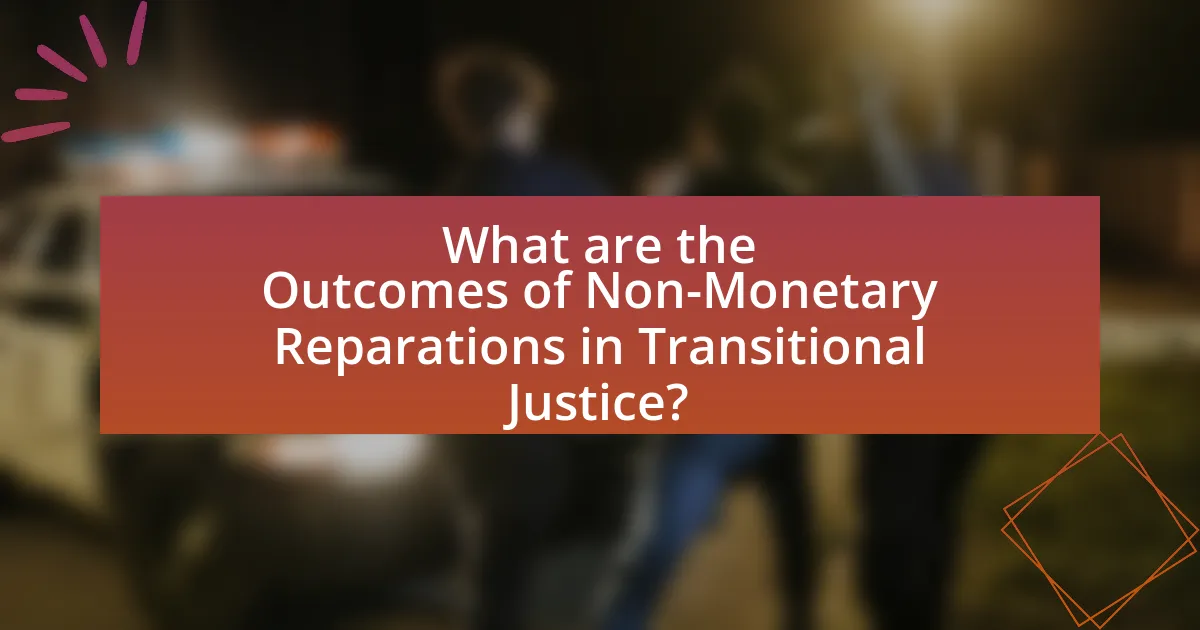
What are the Outcomes of Non-Monetary Reparations in Transitional Justice?
Non-monetary reparations in transitional justice lead to various outcomes, including acknowledgment of victims’ suffering, restoration of dignity, and promotion of social cohesion. These reparations often involve symbolic acts such as public apologies, memorialization of victims, and community-based programs aimed at healing. For instance, in South Africa, the Truth and Reconciliation Commission facilitated public hearings that allowed victims to share their experiences, fostering a collective understanding of past injustices. Research indicates that such reparative measures can enhance community trust and contribute to long-term peacebuilding efforts, as evidenced by studies showing reduced recidivism of violence in post-conflict societies where non-monetary reparations were implemented.
How do Non-Monetary Reparations affect community dynamics?
Non-monetary reparations positively affect community dynamics by fostering social cohesion and promoting healing among affected populations. These reparations, which may include public apologies, memorialization efforts, and community development projects, help to acknowledge past injustices and validate the experiences of victims. For instance, a study by the International Center for Transitional Justice highlights that communities receiving non-monetary reparations often experience a reduction in social tensions and an increase in trust among community members. This is because such reparations facilitate dialogue, encourage collective memory, and support the rebuilding of social networks, ultimately contributing to a more unified community.
What evidence exists regarding the long-term impacts of Non-Monetary Reparations?
Evidence regarding the long-term impacts of non-monetary reparations indicates that they can significantly contribute to healing and reconciliation in post-conflict societies. Studies, such as those conducted by the International Center for Transitional Justice, show that non-monetary reparations, including public acknowledgments, memorialization, and community-building initiatives, foster a sense of justice and recognition among victims. For instance, the Truth and Reconciliation Commission in South Africa highlighted that symbolic reparations, like public apologies and memorials, helped to restore dignity to victims and promote social cohesion. Additionally, research published in the Journal of Peace Research demonstrates that communities receiving non-monetary reparations exhibit lower levels of violence and increased trust in institutions over time, suggesting a positive correlation between these reparations and long-term societal stability.
How do Non-Monetary Reparations influence perceptions of justice among victims?
Non-monetary reparations significantly influence perceptions of justice among victims by addressing their emotional and psychological needs, which monetary compensation often fails to fulfill. Victims often perceive non-monetary reparations, such as public acknowledgment, apologies, and memorialization, as more meaningful because they validate their experiences and suffering. Research indicates that these forms of reparations can foster a sense of dignity and recognition, which are crucial for victims’ healing processes. For instance, a study by the International Center for Transitional Justice highlights that victims who received non-monetary reparations reported higher levels of satisfaction with the justice process compared to those who only received financial compensation. This suggests that non-monetary reparations can enhance victims’ perceptions of justice by promoting reconciliation and restoring their sense of agency.
What lessons can be learned from past implementations of Non-Monetary Reparations?
Past implementations of non-monetary reparations demonstrate that community involvement is crucial for their success. Engaging affected communities in the design and execution of reparative measures fosters ownership and ensures that the initiatives address their specific needs. For instance, the Truth and Reconciliation Commission in South Africa highlighted the importance of public participation in healing processes, leading to greater acceptance and effectiveness of the reparations provided. Additionally, the case of Guatemala’s reparations program revealed that symbolic measures, such as public memorials and acknowledgment of past atrocities, significantly contribute to collective healing and reconciliation. These examples underscore that non-monetary reparations must be tailored to the cultural and social contexts of the affected populations to achieve meaningful outcomes.
What best practices have emerged from successful Non-Monetary Reparations programs?
Successful Non-Monetary Reparations programs have established best practices that include community involvement, acknowledgment of harm, and the provision of services such as education and healthcare. Community involvement ensures that the reparations are tailored to the specific needs of affected populations, fostering a sense of ownership and empowerment. Acknowledgment of harm is crucial as it validates the experiences of victims and promotes healing. Additionally, providing essential services addresses the long-term impacts of injustices, facilitating recovery and reintegration into society. For instance, the Truth and Reconciliation Commission in South Africa emphasized these practices, leading to a more inclusive approach to reparations that contributed to national healing and reconciliation.
How can failures in Non-Monetary Reparations inform future efforts?
Failures in non-monetary reparations can inform future efforts by highlighting the importance of community involvement and the need for culturally sensitive approaches. For instance, the lack of engagement with affected communities in the implementation of reparations has often led to ineffective outcomes, as seen in the case of the Truth and Reconciliation Commission in South Africa, where many victims felt that the reparations did not address their specific needs. This indicates that future reparations should prioritize participatory processes that incorporate the voices and experiences of those directly impacted. Additionally, failures can reveal the necessity for clear communication and transparency in the reparations process, ensuring that beneficiaries understand their rights and the mechanisms available to them. By analyzing these shortcomings, policymakers can develop more effective strategies that are responsive to the unique contexts of affected populations, ultimately enhancing the overall impact of non-monetary reparations in transitional justice.
What practical steps can be taken to enhance the effectiveness of Non-Monetary Reparations?
To enhance the effectiveness of Non-Monetary Reparations, implementing community-based programs that focus on education, health care, and psychological support is essential. These programs can address the specific needs of affected populations, fostering healing and social cohesion. For instance, the Truth and Reconciliation Commission in South Africa emphasized the importance of community engagement in reparative processes, which led to improved trust and collaboration among diverse groups. Additionally, establishing clear frameworks for accountability and monitoring can ensure that reparations are delivered effectively and equitably, as seen in the case of the reparations program in Colombia, which has been evaluated for its impact on victims’ rights and community restoration.
How can community involvement be increased in the design of Non-Monetary Reparations?
Community involvement in the design of Non-Monetary Reparations can be increased by implementing participatory frameworks that actively engage affected populations in the decision-making process. Such frameworks can include community forums, surveys, and workshops that allow individuals to express their needs and preferences regarding reparative measures. Research indicates that when communities are directly involved, the resulting reparations are more likely to address specific grievances and foster healing, as seen in the case of the Truth and Reconciliation Commission in South Africa, which emphasized community input in its reparative strategies. This approach not only enhances the legitimacy of the reparations but also builds trust between communities and governing bodies, ultimately leading to more effective transitional justice outcomes.
What strategies can be employed to ensure sustainability of Non-Monetary Reparations initiatives?
To ensure the sustainability of Non-Monetary Reparations initiatives, integrating community involvement and continuous stakeholder engagement is essential. Engaging affected communities in the design and implementation of reparations fosters ownership and accountability, which are critical for long-term success. For instance, the Truth and Reconciliation Commission in South Africa emphasized community participation, leading to more effective and accepted reparative measures. Additionally, establishing partnerships with local organizations can provide ongoing support and resources, enhancing the initiative’s resilience. Research indicates that initiatives with strong local ties and community backing are more likely to endure, as seen in various post-conflict settings where local governance structures were leveraged to maintain reparative efforts.
